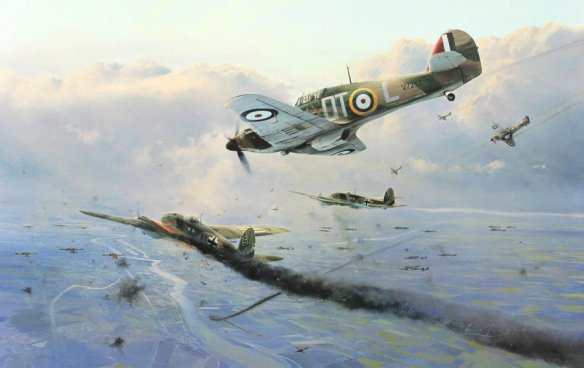RAF Hawker Hurricanes take on Luftwaffe He-111’s in 1940 Battle of Britain.
The German invasion came not by water but by air, because Hermann Göring promised Adolf Hitler that his airmen would win command of the skies before the army and navy crossed the sea. In 1937, while entertaining Lord Trenchard, boasting of the superior powers of his secretly rebuilt Luftwaffe, Göring took his guest outside for a magnificent firework display in the chilly night. Loudspeakers blared out an amplified recording of an artillery barrage, mixed with the whine of dive-bombers swooping to drop their whistling loads of explosive bombs. This was barely two months after the destruction of Guernica. ‘That’s German might for you,’ Göring shouted. ‘I see you trembled. One day German might will make the whole world tremble.’ ‘You must be off your head,’ the founder of the RAF angrily replied. ‘I warn you, Göring, don’t underestimate the RAF.’
From July to October 1940 the Luftwaffe and the RAF clashed above southern England in the series of air combats that became known as the ‘Battle of Britain’. Some doubt if there was ever a coherent German plan; bombers would simply bash Britain until it gave up, which it surely had to. But the illogical British stubbornly refused to surrender, and what ensured was the mythic battle of which Churchill said, in August 1940, ‘Never in the field of human conflict was so much owed by so many to so few.’ The ‘few’ were British, Canadian, Czech, Polish and South African pilots.
London’s Croydon Aerodrome was attacked on 18 August, when the Home Guard managed to shoot down a Dornier with 180 rounds of rifle fire. Central London and the City were first hit by the German air force on the night of the 24th. Then it became a war of tit for tat. RAF Bomber Command bombed ‘military targets’ in the German capital Berlin. Major Nazi reprisal bombing started at teatime on Saturday, 7 September 1940. A huge armada of enemy aircraft flew up the Thames estuary in broad daylight, over 300 bomber planes with more than 600 fighters protecting them. The journalist Virginia Cowles, weekending in the country, saw them in the distance like a swarm of insects. They were heading for the wharves and warehouses.
#
15 October 1940
RAF Spitfire X4418 was shot down by a Spitfire over Maidstone:
“… I was shot down at the end of a battle — and by a Spitfire! This actually happened quite often — a Spitfire shooting down a Spitfire. With inexperienced chaps and the sky full of planes, there wasn’t all that much difference between our fighters and theirs at certain angles. We camouflaged the planes at first, trying to make the wretched things invisible, but then our own anti-aircraft guns used to go for us, so we gave them a more spectacular underside. The incident in question happened over Maidstone on October 15, 1940. There had been an engagement and I was gliding back to Biggin Hill after using up all my ammunition … I throttled back at about 25,000 feet. There was nothing in the sky except three Spitfires behind me. Then suddenly — bang! The aeroplane was full of holes. I was bloody indignant I can tell you. All at once I realised, ‘Christ! I’ve got to bail out!’ I had a bullet through one leg and my controls had gone. I had to get out!
As I was parachuting down I remembered that I was wearing a German Mae West! It was one that had been taken from a crashed plane — they were a sight more comfortable than ours. At that I began to get very worried. There I was dangling on my parachute going down outside Maidstone, and I could see a crowd gathering below. What if someone decided to take a shot at me, I thought! I believe there were instructions then to the Home Guard on how to deal with parachutists — apparently some of the Germans were coming down disguised as nuns! So one instruction said, ‘In order to ascertain sex of the parachutist, put hand up up skirt.’ Those were certainly desperate times! Anyhow, I landed safely, and the crowd soon realised from my language that I was English. In fact, as I said, it was by no means uncommon to be shot down by your own planes. I could name you a half dozen who were — the commander of Biggin Hill for one. And another chap I know of was deliberately shot down and killed by his own squadron. They didn’t like him, apparently …”
Brian Kingcombe
92 Squadron, RAF
See p.72-74, Haining, Peter, ed. The Spitfire Log: A 50th Anniversary Tribute to the World’s Most Famous Fighter Plane (London: Souvenir Press Ltd., 1985)
